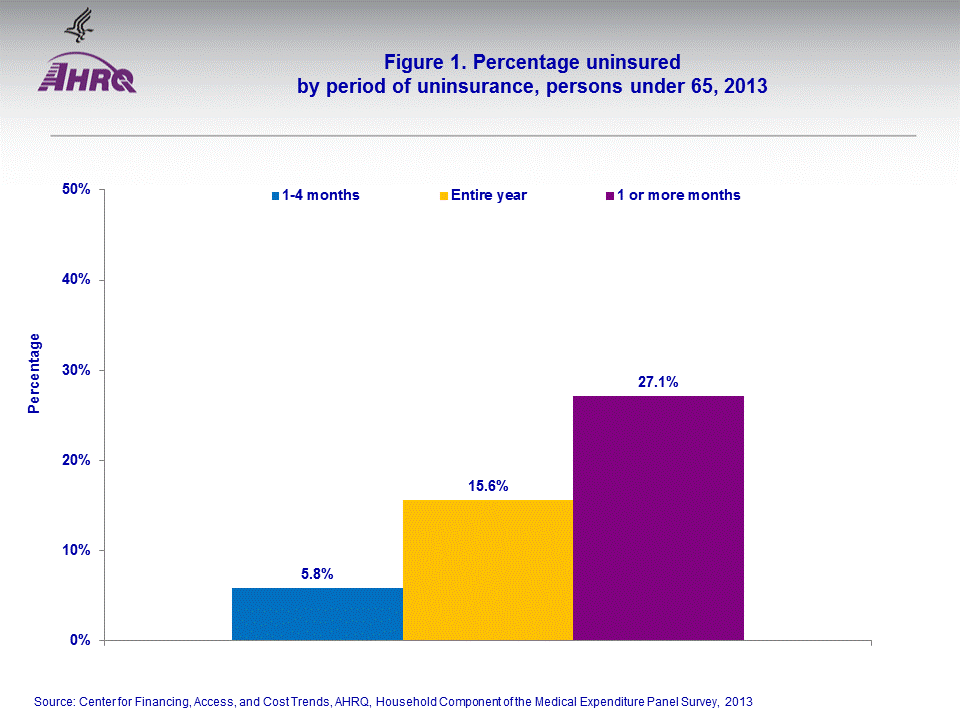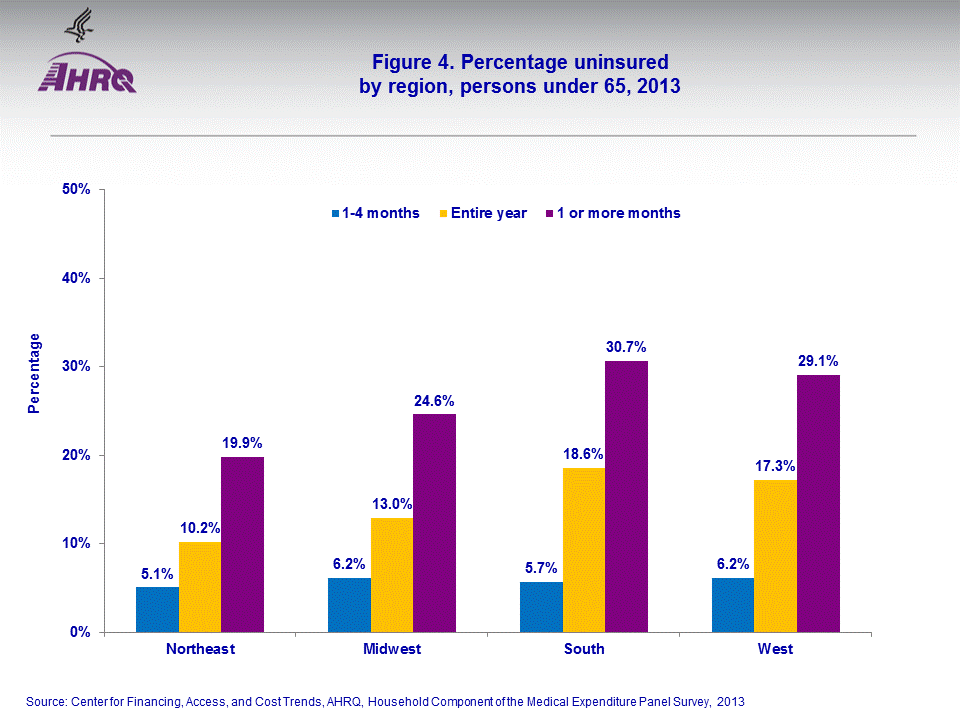
|
|
Font Size:
|
||||
|
|
|
|
||||
STATISTICAL BRIEF #476:
Spells of Uninsurance: Estimates for the U.S. Civilian Noninstitutionalized Population under Age 65, 2013
Highlights
- In 2013, Hispanics were more likely to be uninsured for the entire year or sometime during the year than other racial/ethnic groups.
- In 2013, persons living in the South and West regions were more likely to be uninsured for the entire year or sometime during the year than people living in the Northeast or Midwest.
- Approximately 50 percent of individuals with the lowest hourly wage (less than $10 per hour) were uninsured sometime during the year in 2013. This fraction decreased with increasing wages.
Introduction
Health insurance helps people get timely access to medical care and protects them against the risk of expensive and unanticipated medical events. Estimates of the health insurance status of the U.S. civilian noninstitutionalized population are critical to policymakers and others concerned with access to medical care and the cost and quality of that care. The uninsured population is dynamic, with a substantial number of people gaining and losing coverage in any given year, thus, the importance of considering the duration of uninsurance.Using information from the Household Component of the Medical Expenditure Panel Survey (MEPS-HC), this Statistical Brief provides estimates of the uninsured for varying periods of time for the U.S. civilian noninstitutionalized population under age 65 in 2013. All differences between estimates discussed in the text are statistically significant at the 0.05 level unless otherwise noted.
Findings
The uninsured population is fluid, with many people gaining and losing coverage in a given year.During 2013, 27.1 percent (73.0 million) were uninsured for 1 or more months, with only 5.8 percent (15.7 million) uninsured 1 to 4 months, and 15.6 percent (42.0 million) the entire year (figures 1 and 2).
Percentage uninsured
Hispanics were the most likely race/ethnic group to be uninsured for the entire year or any time during the year. Almost 3 out of 10 (29.2 percent) of Hispanics were uninsured for the entire year and 42.2 percent were uninsured for 1 or more months during 2013 (figure 3).
Persons living in the South and West regions were more likely to be uninsured for the entire year or any time during the year compared to the Northeast and Midwest. In 2013, for individuals living in the South, 18.6 percent were uninsured for the entire year and 30.7 percent were uninsured for one or more months during the year. The corresponding estimates for those living in the West were 17.3 and 29.1 percent, respectively. Individuals in the Northeast were the least likely to be uninsured one or more months (19.9 percent) as compared to the Midwest (24.6 percent), South (30.7 percent), and West (29.1 percent) (figure 4).
Data Source
The estimates shown in this Statistical Brief are drawn from analyses conducted by the MEPS staff from the following public use file: 2013 Full Year Population Characteristics (HC-157).Definitions
UninsuredPeople who did not have health insurance coverage for their entire period of eligibility during the survey year were classified as uninsured for the entire year. People who did not have health insurance coverage for 1 to 4 months were classified as such. People who lacked coverage for at least 1 month during the year were classified as uninsured 1 or more months. People who were covered only by noncomprehensive State-specific programs (e.g., The Maryland Kidney Disease Program) or private single-service plans (e.g., coverage for dental or vision care only, coverage for accidents or specific diseases) were considered to be uninsured.
Race/ethnicity
Classification by race/ethnicity was based on information reported for each family member. Respondents were asked if each family member's race was best described as American Indian, Alaska Native, Asian, black, white, Pacific Islander, or other. They were also asked if each family member's main national origin or ancestry was Puerto Rican; Cuban; Mexican, Mexicano, Mexican American, or Chicano; other Latin American; or other Spanish. All persons whose main national origin or ancestry was reported in one of these Hispanic groups, regardless of racial background, were classified as Hispanic. MEPS respondents who reported other races and were non-Hispanic were included in the other category. For this analysis, the following classification by race and ethnicity was used: Hispanic (of any race), black non-Hispanic, white non-Hispanic, Asian non-Hispanic, and other non-Hispanic.
Region
Each MEPS sampled person was classified as living in one the following four regions as defined by the U.S. Census Bureau:
- Northeast: Maine, New Hampshire, Vermont, Massachusetts, Rhode Island, Connecticut, New York, New Jersey, and Pennsylvania.
- Midwest: Ohio, Indiana, Illinois, Michigan, Wisconsin, Minnesota, Iowa, Missouri, South Dakota, North Dakota, Nebraska, and Kansas.
- South: Delaware, Maryland, District of Columbia, Virginia, West Virginia, North Carolina, South Carolina, Georgia, Florida, Kentucky, Tennessee, Alabama, Mississippi, Arkansas, Louisiana, Oklahoma, and Texas.
- West: Montana, Idaho, Wyoming, Colorado, New Mexico, Arizona, Utah, Nevada, Washington, Oregon, California, Alaska, and Hawaii.
Hourly wage estimates were derived for all persons who reported being employed but not self-employed. In the simplest case, hourly wage was reported directly by the respondent. For other persons, construction of the hourly wage was based upon salary, the time period on which the salary was based, and the number of hours worked per time period. If the number of hours worked per time period was not available, a value of 40 hours per week was assumed. Hourly wage was imputed for those individuals identified as employed (but not self-employed) but did not know their wage or refused to report a wage. Additionally, wages were imputed for wage earners reporting a wage range and not a specific value. For each of these persons, a value was imputed from other persons on the file who did report a specific value that fell within the reported range.
About MEPS-HC
MEPS-HC is a nationally representative longitudinal survey that collects detailed information on health care utilization and expenditures, health insurance, and health status, as well as a wide variety of social, demographic, and economic characteristics for the U.S. civilian noninstitutionalized population. It is co-sponsored by the Agency for Healthcare Research and Quality and the National Center for Health Statistics.For more information about MEPS, call the MEPS information coordinator at AHRQ (301-427-1656) or visit the MEPS Web site at http://www.meps.ahrq.gov/.
References
Congress of the United States Congressional Budget Office (prepared by Lyle Nelson). How Many People Lack Health Insurance and For How Long? May 2003. http://www.cbo.gov/sites/default/files/cbofiles/ftpdocs/42xx/doc4210/05-12-uninsured.shtmlFor a detailed description of the MEPS-HC survey design, sample design, and methods used to minimize sources of nonsampling error, see the following publications:
Cohen, J. Design and Methods of the Medical Expenditure Panel Survey Household Component. MEPS Methodology Report No. 1. AHCPR Pub. No. 97-0026. Rockville, MD: Agency for Health Care Policy and Research, 1997. http://meps.ahrq.gov/mepsweb/data_files/publications/mr1/mr1.shtml
Cohen, S. Sample Design of the 1996 Medical Expenditure Panel Survey Household Component. MEPS Methodology Report No. 2. AHCPR Pub. No. 97-0027. Rockville, MD: Agency for Health Care Policy and Research, 1997. http://meps.ahrq.gov/mepsweb/data_files/publications/mr2/mr2.shtml
Cohen, S. Design Strategies and Innovations in the Medical Expenditure Panel Survey. Medical Care, July 2003: 41(7) Supplement: III-5–III-12.
Ezzati-Rice, T.M., Rohde, F., Greenblatt, J. Sample Design of the Medical Expenditure Panel Survey Household Component, 1998–2007. Methodology Report No. 22. March 2008. Agency for Healthcare Research and Quality, Rockville, MD. http://www.meps.ahrq.gov/mepsweb/data_files/publications/mr22/mr22.shtml
Suggested Citation
Rhoades, J. Spells of Uninsurance: Estimates for the U.S. Civilian Noninstitutionalized Population under Age 65, 2013. Statistical Brief #476. June 2015. Agency for Healthcare Research and Quality, Rockville, MD. http://www.meps.ahrq.gov/mepsweb/data_files/publications/ss476/stat476.shtmlAHRQ welcomes questions and comments from readers of this publication who are interested in obtaining more information about access, cost, use, financing, and quality of health care in the United States. We also invite you to tell us how you are using this Statistical Brief and other MEPS data and tools and to share suggestions on how MEPS products might be enhanced to further meet your needs. Please email us at MEPSProjectDirector@ahrq.hhs.gov or send a letter to the address below:
Steven B. Cohen, PhD, Director
Center for Financing, Access, and Cost Trends
Agency for Healthcare Research and Quality
540 Gaither Road
Rockville, MD 20850
 |
||||||||||||||||||||||||||||
|
||||||||||||||||||||||||||||
|
|
||||||||||||||||||||||||||||
 |
||||||||||||||||||||||||||||
|
||||||||||||||||||||||||||||
|
|
||||||||||||||||||||||||||||
 |
||||||||||||||||||||||||||||
|
||||||||||||||||||||||||||||
|
|
||||||||||||||||||||||||||||
 |
||||||||||||||||||||||||||||
|
||||||||||||||||||||||||||||
|
|
||||||||||||||||||||||||||||
 |
||||||||||||||||||||||||||||
|
||||||||||||||||||||||||||||
|
|
||||||||||||||||||||||||||||


